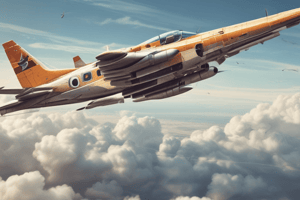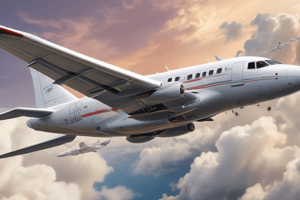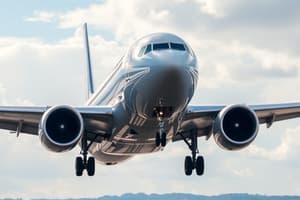Podcast
Questions and Answers
What factor is most directly responsible for the load factor experienced during a turn in flight?
What factor is most directly responsible for the load factor experienced during a turn in flight?
- Wing loading
- Bank angle (correct)
- Weight of the aircraft
- Speed of the aircraft
Which scenario describes the corner velocity in a V-n diagram?
Which scenario describes the corner velocity in a V-n diagram?
- The maximum speed before stalling
- The speed corresponding to the maneuver point (correct)
- The lowest speed achievable in a turn
- The speed where structural limits are reached
In the context of stall, which of the following is the primary limiting factor for low speed in flight?
In the context of stall, which of the following is the primary limiting factor for low speed in flight?
- Pilot's ability to control the aircraft
- Structural limits of the aircraft (correct)
- Load factor during a turn
- Lift produced by the wings
What does the 'g' limit in flight dynamics refer to?
What does the 'g' limit in flight dynamics refer to?
During turning flight, what happens when the load factor exceeds the aircraft's design limits?
During turning flight, what happens when the load factor exceeds the aircraft's design limits?
What is primarily limited by the structural design of an airplane during high-speed maneuvers?
What is primarily limited by the structural design of an airplane during high-speed maneuvers?
In a power-off glide, which condition must be managed to maintain lift?
In a power-off glide, which condition must be managed to maintain lift?
What is the relationship between the smallest possible turn radius and the largest possible turn rate at the maneuver point?
What is the relationship between the smallest possible turn radius and the largest possible turn rate at the maneuver point?
What is the significance of the maximum lift-to-drag ratio (L/D)max in power-off gliding?
What is the significance of the maximum lift-to-drag ratio (L/D)max in power-off gliding?
In a coordinated level turn, how does the lift vector behave?
In a coordinated level turn, how does the lift vector behave?
Which component of lift directly counteracts the weight of the aircraft during a level turn?
Which component of lift directly counteracts the weight of the aircraft during a level turn?
What happens to the load factor when an aircraft performs a pull-up maneuver?
What happens to the load factor when an aircraft performs a pull-up maneuver?
What is the role of radial acceleration in turning flight dynamics?
What is the role of radial acceleration in turning flight dynamics?
How is load factor commonly expressed in aviation?
How is load factor commonly expressed in aviation?
What is the primary effect of a bank angle during a level turn?
What is the primary effect of a bank angle during a level turn?
What typically happens to an aircraft's altitude during a level turn?
What typically happens to an aircraft's altitude during a level turn?
What is the main reason for minimizing drag in a power-off glide?
What is the main reason for minimizing drag in a power-off glide?
Which equation is typically used to calculate glide performance when considering airspeed?
Which equation is typically used to calculate glide performance when considering airspeed?
What effect does turning flight have on load factors?
What effect does turning flight have on load factors?
Which of the following best describes flight path angles during a glide?
Which of the following best describes flight path angles during a glide?
What is the primary factor affecting the dynamics of turning flight?
What is the primary factor affecting the dynamics of turning flight?
In a power-off glide, if drag increases, what happens to the glide ratio?
In a power-off glide, if drag increases, what happens to the glide ratio?
Which factor does NOT directly influence glide performance?
Which factor does NOT directly influence glide performance?
What is a significant result of having a forward center of gravity during gliding?
What is a significant result of having a forward center of gravity during gliding?
What is the primary purpose of the glide polar in a glider's flight manual?
What is the primary purpose of the glide polar in a glider's flight manual?
How does drag affect glide performance?
How does drag affect glide performance?
What happens to the glide ratio as airspeed varies?
What happens to the glide ratio as airspeed varies?
What is the consequence of having an imbalanced center of gravity during flight?
What is the consequence of having an imbalanced center of gravity during flight?
Which aspect of a forward center of gravity primarily affects aircraft performance?
Which aspect of a forward center of gravity primarily affects aircraft performance?
What is the load factor typically quoted in terms of?
What is the load factor typically quoted in terms of?
During a coordinated level turn, what remains constant about the aircraft's performance?
During a coordinated level turn, what remains constant about the aircraft's performance?
In what scenario is minimizing drag critically important during flight?
In what scenario is minimizing drag critically important during flight?
What is the effect of the center of gravity on the aircraft's stability?
What is the effect of the center of gravity on the aircraft's stability?
What happens to the lift vector during a level turn?
What happens to the lift vector during a level turn?
What is a key characteristic of the lift generated by an aircraft during straight and level flight?
What is a key characteristic of the lift generated by an aircraft during straight and level flight?
In the context of turning flight, which component of lift acts to maintain altitude?
In the context of turning flight, which component of lift acts to maintain altitude?
What is the significance of the maximum lift-to-drag ratio (L/D)max in gliding?
What is the significance of the maximum lift-to-drag ratio (L/D)max in gliding?
In a power-off glide, what is primarily affected if drag increases?
In a power-off glide, what is primarily affected if drag increases?
What is likely to occur during a pull-up maneuver in terms of load factor?
What is likely to occur during a pull-up maneuver in terms of load factor?
What is the relationship of turn radius to turn rate at a maneuver point?
What is the relationship of turn radius to turn rate at a maneuver point?
What defines the minimum sink speed for a glider?
What defines the minimum sink speed for a glider?
How can the best glide speed for a glider be identified from the glide polar?
How can the best glide speed for a glider be identified from the glide polar?
What determines the corner velocity on a V-n diagram?
What determines the corner velocity on a V-n diagram?
What happens to the glide polar when the mass of a glider is increased with water ballast?
What happens to the glide polar when the mass of a glider is increased with water ballast?
What does the best glide ratio allow a glider to achieve?
What does the best glide ratio allow a glider to achieve?
In the context of load factors during a turn, what primarily affects the aircraft's performance?
In the context of load factors during a turn, what primarily affects the aircraft's performance?
What is a critical aspect of the maneuver point in relation to structural limits?
What is a critical aspect of the maneuver point in relation to structural limits?
What factor remains approximately the same when water ballast is added to a glider?
What factor remains approximately the same when water ballast is added to a glider?
Which of the following best describes how high-speed maneuvers are constrained?
Which of the following best describes how high-speed maneuvers are constrained?
Which equation describes the relationship between lift-to-drag ratio (L/D) and glide angle?
Which equation describes the relationship between lift-to-drag ratio (L/D) and glide angle?
What does the term 'g' limit refer to in an aircraft's flight dynamics?
What does the term 'g' limit refer to in an aircraft's flight dynamics?
In a power-off glide scenario, which force must primarily be balanced to maintain lift?
In a power-off glide scenario, which force must primarily be balanced to maintain lift?
During a pull-up maneuver, how does the load factor typically behave?
During a pull-up maneuver, how does the load factor typically behave?
Which of the following factors is NOT associated with generating lift during gliding?
Which of the following factors is NOT associated with generating lift during gliding?
What primarily limits an airplane's performance during low-speed flight?
What primarily limits an airplane's performance during low-speed flight?
Flashcards
Glide angle (minimum)
Glide angle (minimum)
The smallest angle an aircraft can glide maintaining a relatively constant altitude while losing vertical height.
Maximum glide range (CP-1)
Maximum glide range (CP-1)
Maximum horizontal distance covered during a power-off glide starting at 10,000 ft for a CP-1 aircraft.
(L/D)max
(L/D)max
Maximum lift-to-drag ratio, a measure of an aircraft's efficiency in gliding.
Level turn (Coordinated)
Level turn (Coordinated)
Signup and view all the flashcards
Bank Angle
Bank Angle
Signup and view all the flashcards
Load Factor
Load Factor
Signup and view all the flashcards
Centripetal Force
Centripetal Force
Signup and view all the flashcards
Turn Radius
Turn Radius
Signup and view all the flashcards
Four Forces of Flight
Four Forces of Flight
Signup and view all the flashcards
Lift
Lift
Signup and view all the flashcards
Weight
Weight
Signup and view all the flashcards
Center of Gravity (CG)
Center of Gravity (CG)
Signup and view all the flashcards
Adverse Forward CG
Adverse Forward CG
Signup and view all the flashcards
Adverse Rear CG
Adverse Rear CG
Signup and view all the flashcards
Straight and Level Flight
Straight and Level Flight
Signup and view all the flashcards
Glide
Glide
Signup and view all the flashcards
Load Factor (L/W)
Load Factor (L/W)
Signup and view all the flashcards
Load Factor in a Turn
Load Factor in a Turn
Signup and view all the flashcards
Load Factor & Bank Angle
Load Factor & Bank Angle
Signup and view all the flashcards
Wing Loading
Wing Loading
Signup and view all the flashcards
Wing Loading & Stall Speed
Wing Loading & Stall Speed
Signup and view all the flashcards
G-Limit
G-Limit
Signup and view all the flashcards
V-n Diagram
V-n Diagram
Signup and view all the flashcards
Maneuver Point
Maneuver Point
Signup and view all the flashcards
Stall Speed
Stall Speed
Signup and view all the flashcards
Glide Ratio
Glide Ratio
Signup and view all the flashcards
Glide Angle
Glide Angle
Signup and view all the flashcards
Maximum Glide Range
Maximum Glide Range
Signup and view all the flashcards
Lift-to-Drag Ratio (L/D)
Lift-to-Drag Ratio (L/D)
Signup and view all the flashcards
Centrifugal Force in a Turn
Centrifugal Force in a Turn
Signup and view all the flashcards
Centripetal Force in a Turn
Centripetal Force in a Turn
Signup and view all the flashcards
Best Glide Speed
Best Glide Speed
Signup and view all the flashcards
Minimum Sink Rate
Minimum Sink Rate
Signup and view all the flashcards
How does adding water ballast affect a glider's glide performance?
How does adding water ballast affect a glider's glide performance?
Signup and view all the flashcards
Equation for Glide Angle
Equation for Glide Angle
Signup and view all the flashcards
Glide Angle & L/D Ratio
Glide Angle & L/D Ratio
Signup and view all the flashcards
What is the significance of a glider's maximum L/D?
What is the significance of a glider's maximum L/D?
Signup and view all the flashcards
Corner Velocity
Corner Velocity
Signup and view all the flashcards
Study Notes
Theory of Flight
- Four forces act on an airplane: thrust, lift, weight, and drag.
- Thrust is the forward force propelling the airplane.
- Lift is the upward force supporting the airplane.
- Weight is the downward pull of gravity.
- Drag is the backward force resisting the airplane's movement.
Introduction
- Students will be able to describe the relationship between lift, weight, thrust, and drag.
- Students will be able to describe glide ratio.
- Students will be able to describe steady-state flight and performance.
- Students will be able to describe the theory of the turn.
- Students will be able to describe load factor and its influence on stalling, flight envelope, and structural limitations.
- Students will be able to describe methods of lift augmentation.
Four Forces of Flight
- Lift is produced by airflow over and under wings.
- Weight opposes lift, caused by gravity.
- Thrust moves the aircraft forward, determined by engine power.
- Drag opposes thrust, limiting speed.
Vectors
- Arrows representing forces are called vectors.
- Vector length indicates magnitude, and orientation shows direction.
- Several forces acting simultaneously combine to create a resultant force.
Lift
- Lift is the key aerodynamic force opposing weight.
- Airplane is in equilibrium when lift equals weight.
- Wing design creates a pressure differential (high below, low above) creating lift.
Weight
- Weight acts downward through the center of gravity (CG).
- Lift counteracts weight to maintain altitude.
- CG is the point where all the aircraft's weight is concentrated.
Center of Gravity
- CG is the point where the weight of the aircraft acts.
- Maintaining balance between lift and weight keeps the airplane in straight-and-level flight.
Adverse Forward Center of Gravity
- Too much weight forward shifts the CG forward.
- This can lead to increased tendency to dive, difficulty raising the nose, oscillations, and issues with flap operation, spin characteristics.
Adverse Rear Center of Gravity
- Too much weight aft leads to a rearward shifted CG.
- The possible consequences include decreased flying speed, decreased range, increased stalling tendency, spin characteristics, and poor stability.
Effect of Stall Speed on Centre of Gravity
- This topic is about how stall speed is affected by the location of the center of gravity (CG).
Imbalanced Centre of Gravity
- An imbalance in center of gravity position affects the stability of the aircraft.
Effect of Forward Centre of Gravity on Aircraft Performance and Stability
- Forward CG decreases performance and increases stability.
- Forward CG increases drag and indicated stall speed.
Effect of Aft Centre of Gravity on Aircraft Performance and Stability
- Aft CG increases performance and decreases stability.
- Aft CG decreases drag and indicated stall speed.
Lifting Forces
- Airflow over an airfoil (curved surface) creates a pressure difference.
- High pressure under the wing, low pressure above the wing.
- Resultant force pushes the aircraft upwards.
Center of Gravity Limits
- Each aircraft has specific CG limits (typically 15% to 40% of wing chord).
- CG position changes during flight due to fuel consumption and passenger/cargo movement.
- CG location affects pitch attitude.
Straight and Level Flight
- Lift equals weight, and thrust equals drag in straight-and-level flight at constant airspeed.
- Thrust changes are required for acceleration or descent.
Forces in a Climb
- Thrust balances drag plus a portion of the weight.
- Higher climbing angles result in lower lift and require greater thrust.
Forces in a Descent
- Gravity aids thrust in reducing the required thrust.
- Lift is less than weight, drag balanced by reduced thrust.
The Glide
- Thrust is removed, lift and drag counteract weight for a steady glide.
- Glide angle is influenced by lift/drag ratio.
- Optimal glide angle corresponds to max lift/drag ratio.
Glide Angle
- A glider's glide angle is determined by the change in altitude divided by the horizontal distance flown during descent.
Aircraft Glide Ratio
- Glide ratio relates horizontal distance traveled to altitude lost.
- Lower sink rate, higher glide ratio.
- A glide polar allows estimation of glide ratio at various speeds.
Aircraft Glide Ratio (continued)
- Airspeed and sink rate are used to determine minimum sink speed.
- The graph is used to find the minimum sink speed and related airspeed.
Aircraft Glide Ratio (continued)
- Best glide speed (or best L/D speed) is the airspeed for the highest glide ratio.
- Glide ratio can be calculated from a graph of sink rate vs. airspeed.
- Glide speed maximizes the distance flown for each unit of altitude lost.
Glider Fly
- This is about the operation and performance of gliders in flight.
Gliding Flight
- Power-off glide (T = 0) occurs with no thrust.
- Lift must balance drag and weight in a constant glide angle.
Equations of motion for power-off glide
- Equations that describe the forces acting on an airplane in a power-off glide related to glide angle.
Example
- Examples of calculations related to the topic of gliding in flight
Example 2
- Examples of calculation for different types of aeroplanes.
Centrifugal Force
- Outward force felt by an object moving in a circle.
- Centripetal force pulls objects inwards.
Centripetal Force
- Force needed to keep a body moving in a circle.
Aircraft Turn
- Inertia must be overcome to start a turn.
- Banking the aircraft creates a horizontal component of lift (centripetal force).
Turning Flight
- Turning requires overcoming inertia and tilting lift.
- Horizontal component provides centripetal force for turning.
- Maintaining altitude involves increasing lift component.
Sideslip
- Sideslip occurs when the aircraft bank angle is too great.
Skidding
- Sideslip is the opposite of a skid (which happens when the bank angle is too small for a coordinated turn).
- Centrifugal force causes an outward skidding tendency.
Sideway Landing
- Describing a sideway landing.
Cross Wind landing
- This section describes a cross-wind landing.
Balanced Turn
- During a balanced turn, the pilot experiences no sliding.
- Effective weight is equivalent to lift, magnified accordingly.
Turning Flight and The V-n Diagram
- Graph relating airspeed, load factor, and turning capabilities.
Level Turn (Coordinated turn)
- An airplane in a level turn experiences a constant altitude with a horizontal component of lift (centripetal force) providing the turning force to match the turn radius.
- A component of lift is to resist gravity (to hold altitude).
- The resultant force in level turn flight is the square root of the sum of the horizontal and vertical components of lift force.
Level turn
- The lift vector is tilted during a bank to provide necessary centripetal force for turn.
- A component of lift equals weight, maintaining altitude.
- The resultant centripetal force is calculated using a Pythagorean theorem.
Load Factor
- Ratio of lift to weight during a turn.
- Load factor increases with increased bank angle.
- Load factor affects structural loads on aircraft components.
- Increased bank angle leads to increased load factor and increased loads on aircraft components.
Load Factor During a Turn
- Lift on wings increases to counteract increased weight during turns.
- Increased angle of bank leads to substantial increases in lift.
- The struts and spars must be able to withstand the greatly increased loads during turning maneuvers.
Load Factor Angle of Bank
- Minimum speed during a bank is defined mathematically as W/L = cos e or L = W/Cos e.
Load Factor Angle of Bank(continued)
- There is a relationship between the stalling speed and angle of bank.
Wing Loading
- Wing loading is the ratio of weight to wing area.
- Lower wing loading corresponds to a lower minimum speed and higher wing loading to a higher minimum speed.
Wing Loading Stalling Speed
- Lower wing loading means a lower stalling speed.
- Higher wing loading means a higher stalling speed.
"g" Limit
- "g" limit represents the maximum load factor an aircraft can withstand to avoid structural failure.
How to survive high G force?
- Methods and techniques applicable to high-G force conditions.
"g" Limit from V-n Diagram
- Diagram depicting the relationships among airspeed, load factor, stall speed, and structural limits in flight.
V-n diagram
- A graph showing flight envelope limits, particularly for maneuverability.
Maneuver point
- A point in the V-n diagram where load factor and lift coefficient are at their maximum values during a turn.
- Point where maximum load factor and highest velocity for turn is possible.
Corner velocity (V*)
- Velocity at the maneuver point where load factor and lift coefficient are at their maximum in aircraft turns.
V-n diagram (Low speed)
- Graph describing the relationship between load factor, airspeed, and stall speed when limiting conditions are low speeds.
V-n diagram (High-speed)
- Graph describing the relationship between load factor, airspeed, and stall speed in high-speed flight.
Studying That Suits You
Use AI to generate personalized quizzes and flashcards to suit your learning preferences.




